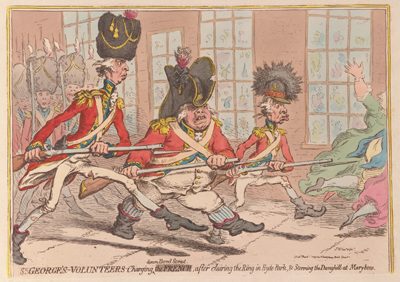St George's Volunteers Charging Down Bond Street
This print shows a laughably incongrous trio of volunteer soldiers (tall, short, fat, and thin) in military but tattered dress, using their new-found soldiering skills in the most energetic and inappropriate of ways. The (relative) uniformity of their forward advance—legs outstretched, hands on their muskets—is comically contrasted with the variety in their physiques, headdress, and expressions and, of course, the ludicrousness of their seeming objective.

© Beinecke Rare Book and Manuscript Library, Yale University
The full title of this print, St George's Volunteers Charging the French Down Bond Street
after Clearing the Ring in Hyde Park, & Storming the Dunghill at Marybone carries on
the same comic contrast between the militaristic and the mundane.
Our redoubtable trio are "charging" not at the French, but "down Bond Street"
where the only hint of France likely to be found is in the fashions of the fleeing ladies. They have routed
the enemy in Hyde Park, "clearing the Ring" of the titled and fashionable who regularly
drove the ring in their carriages. And they have returned from "storming" a particularly
challenging hill—a dunghill at Marybone, a perhaps sly commentary on a less than wholesome part
of town in Gillray's day.
As usual there is much to admire in the way Gillray has arranged the figures to create a sense of movement and energy. The eye follows the succession of figures from foreground to background, from left to right, and from high to low, moving along with the fleeing maidens right off the page. And as in Gillray's March to the Bank (1787), the background solidiers and shop windows provide a normative order against which everything else is contrasted.
This is the first of two prints within a week devoted to the voluntary armies being created across across Britain in response to the threat of French invasion. This threat was more real than ever in the wake of the failed invasion of Ireland in December 1796. According to Cecil Sebag-Montefiore in his History of the Volunteer Forces from the Earliest Times to the Year 1860, the five companies of the St. George's Volunteers were the first of the volunteer units to be enrolled (1794) after the declaration of war against France.(p. 164)
Sources and Reading
- Commentary from the British Museum on St George's Volunteers Charging Down Bond Street. . ..
- Draper Hill, Fashionable Contrasts, 1966, #20
- "British Volunteer Corps," Wikipedia
- "Militia (Great Britain)," Wikipedia
- Cecil Sebag-Montefiore, A History of the Volunteer Forces from the Earliest Times to the Year 1860, 1908
- Thomas Wright and R.H. Evans, Historical and Descriptive Account of the Caricatures of James Gillray #183
- Thomas Wright and Joseph Grego, The Works of James Gillray, the Caricaturist; With the History of His Life and Times, p. 221.
Comments & Corrections
NOTE: Comments and/or corrections are always appreciated. To make that easier, I have included a form below that you can use. I promise never to share any of the info provided without your express permission.